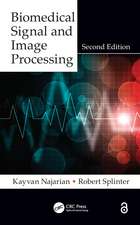Hydrogels: Biological Properties and Applications
Editat de Rolando Barbuccien Limba Engleză Hardback – 28 dec 2008
| Toate formatele și edițiile | Preț | Express |
|---|---|---|
| Paperback (1) | 383.33 lei 43-57 zile | |
| Springer – 2 dec 2014 | 383.33 lei 43-57 zile | |
| Hardback (1) | 373.84 lei 43-57 zile | |
| Springer – 28 dec 2008 | 373.84 lei 43-57 zile |
Preț: 373.84 lei
Preț vechi: 393.52 lei
-5% Nou
Puncte Express: 561
Preț estimativ în valută:
71.56€ • 77.75$ • 60.15£
71.56€ • 77.75$ • 60.15£
Carte tipărită la comandă
Livrare economică 21 aprilie-05 mai
Preluare comenzi: 021 569.72.76
Specificații
ISBN-13: 9788847011038
ISBN-10: 8847011035
Pagini: 212
Ilustrații: XI, 197 p.
Dimensiuni: 155 x 235 x 17 mm
Greutate: 0.54 kg
Ediția:2009
Editura: Springer
Colecția Springer
Locul publicării:Milano, Italy
ISBN-10: 8847011035
Pagini: 212
Ilustrații: XI, 197 p.
Dimensiuni: 155 x 235 x 17 mm
Greutate: 0.54 kg
Ediția:2009
Editura: Springer
Colecția Springer
Locul publicării:Milano, Italy
Public țintă
ResearchCuprins
Hydrogels and Tissue Engineering.- Structure-Property Relationships in Hydrogels.- Water and Surfaces: a Linkage Unexpectedly Profound.- Polysaccharide Based Hydrogels for Biomedical Applications.- Hydrogels for Healing.- Stereocomplexed PEG-PLA Hydrogels.- Hybrid Hydrogels Based on Poly(vinylalcohol)-Chitosan Blends and Relevant CNT Composites.- Poloxamine Hydrogels: from low Cell Adhesion Substrates to Matrices with Improved Cytocompatibility for Tissue Engineering Applications.- Biohydrogels for the In Vitro Re-construction and In Situ Regeneration of Human Skin.- Chitosan-Based Beads for Controlled Release of Proteins.- Synthesis of Stimuli-Sensitive Hydrogels in the ?m and sub-?m Range by Radiation Techniques and their Application.- Stimuli-Sensitive Composite Microgels.- Novel pH/Temperature-Sensitive Hydrogels Based on Poly(?-Amino Ester) for Controlled Protein Delivery.- On-Off Switching Properties of ultra thin Intelligent Temperature-Responsive Polymer Modified Surface.
Textul de pe ultima copertă
The studies on Biohydrogels have had a rapid, exponential evolution in the last
decades. Starting from one of the first applications of hydrogels in surgery,
polyvinylalcohol crosslinked with formaldehyde under the trade name of Ivalon, we
passed through PolyHema hydrogels as contact lens materials, hydrophilic
polyurethanes (HPU), biodegradable hydrogels for both reconstructive surgery and
pharmaceutical delivery systems, and finally more recently, one decade old, the
thermoreversible and transient network hydrogels. Of course all these classes of
hydrogels have been always and continuosly studied, improving their performance and
field of applications. Recently, most of them have been used as scaffolds for cells,
even stem ones, for regenerative applications (tissue engineering). Nevertheless
hydrogels are odd materials and many studies still have to be carried out to fully
understand their behaviour from mechanical, physicochemical and biological point of
view.
decades. Starting from one of the first applications of hydrogels in surgery,
polyvinylalcohol crosslinked with formaldehyde under the trade name of Ivalon, we
passed through PolyHema hydrogels as contact lens materials, hydrophilic
polyurethanes (HPU), biodegradable hydrogels for both reconstructive surgery and
pharmaceutical delivery systems, and finally more recently, one decade old, the
thermoreversible and transient network hydrogels. Of course all these classes of
hydrogels have been always and continuosly studied, improving their performance and
field of applications. Recently, most of them have been used as scaffolds for cells,
even stem ones, for regenerative applications (tissue engineering). Nevertheless
hydrogels are odd materials and many studies still have to be carried out to fully
understand their behaviour from mechanical, physicochemical and biological point of
view.












